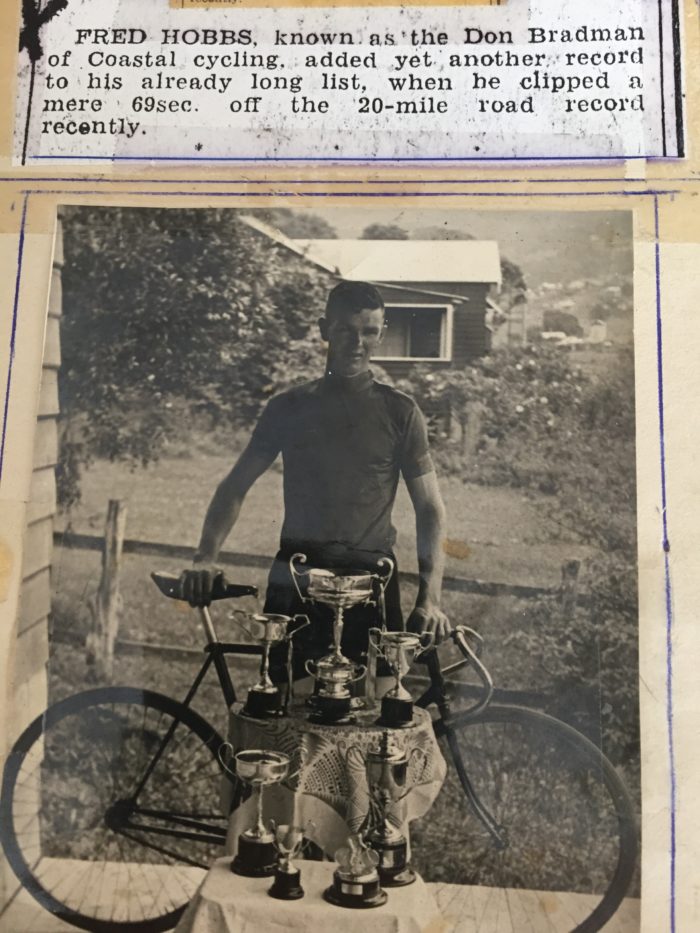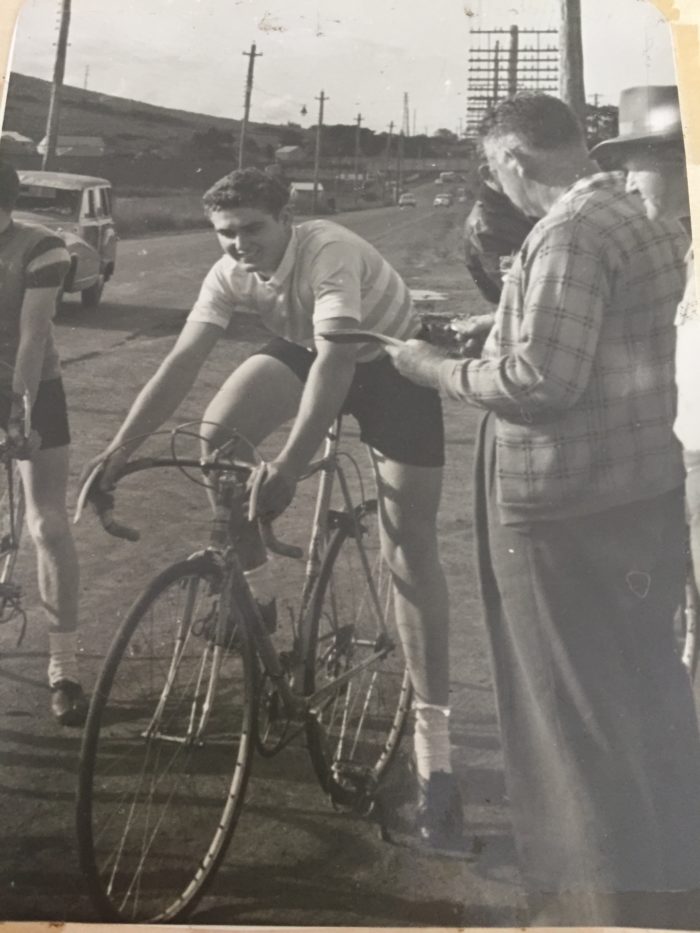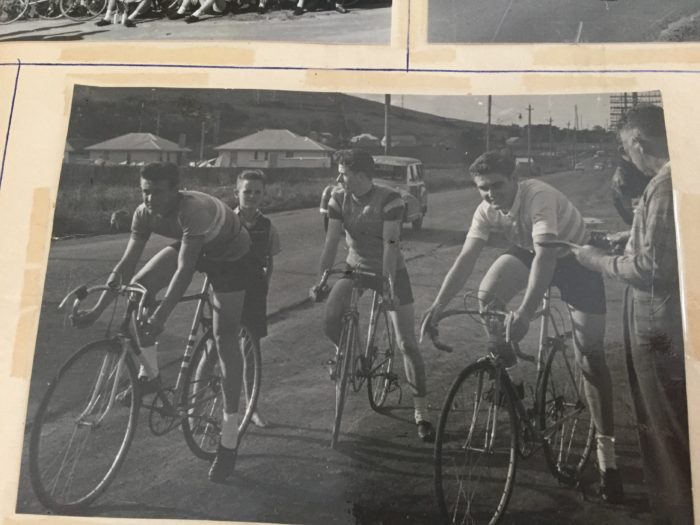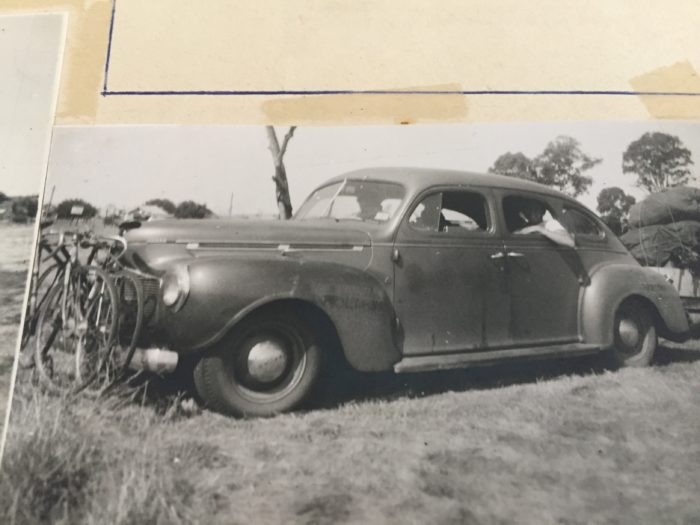The Ken Dinnerville Story.
Wherever I’ve traveled on this planet, I’ve got to meet and speak to some very interesting people. This story is about someone who lives in Dapto New South Wales. So how did this opportunity come along to interview Mr. Ken Hobbs, and why was he important to my story.
Well this is how it all came about.
During an Illawarra Cycling Club meeting, the topic of the Ken Dinnerville Memorial Bike Race was raised. It seemed that everyone had raced this event, but no one could tell me the entire story behind the race. One of our club members gave me a name to contact, Mrs. Cleary. Now I know Mrs. Clearly, as she hands out the trophy to the winner of the Dinnerville each year. Something I’m still waiting to win one day. I spoke to Mrs. Cleary recently, and she informed me she was the Aunty of Ken Dinnerville. Kenny was tragically killed in a bicycle accident in 1956. Mrs. Cleary gave me the name of Ken Hobbs to speak too. I personally knew Ken Hobbs from when I was racing many years ago. Ken has lived with his wife Cath in Dapto for many years, and I still ride past his house each week to this day.
On the 6th October 2017 whilst riding with my buddy around the lake, I decided to stop in and have a brief chat with Ken, and see if he was prepared to sit down and be interviewed about young Kenny Dinnerville. I was warmly greeted by Ken and his wife and invited in. I asked Ken if he knew much about Ken Dinnerville, and to my surprise he said’
“Do I know Ken Dinnerville? I was out training with him when he clipped my rear wheel and fell off his biker and went straight under a truck”
Well, that nearly knocked me over. After a brief chat, Ken agreed for me to come back the next week to learn all about young Kenny Dinnerville, as long as I brought the cake.
Sunday 15th October 2017.
Ken Hobbs was born in 1937, and raised in Mt Keira, New South Wales, Australia.
I’m a true believer that everyone has a story to tell about life, and Ken was no different. He told me that his grandfather came to Picton at the age of 18 from Victoria, he was a professional rabbit trapper.
‘My grandmother worked as a house maid at King George’s Hotel Picton. I think it’s closed now. The family then moved to O’Brien’s road Figtree. My father, Fred Hobbs, worked on the Railway, and had little education. My dad learnt to read and write by reading comics at night, as the workers on the railway sat in the tent at night. Dad would read the comics under candlelight’.
Ken’s father, Fred Hobbs, was a champion cyclist who held many records for cycling throughout NSW, and the Illawarra region. Fred Hobbs was known as the ‘Don Bradman’ of coastal cycling. Fred was known to free wheel down the finishing straight with the goal of coming 2nd or 3rd in the race. See in those days, winners received a trophy, whilst 2nd and 3rd received money. Because times were tough, it was a better to take home money than a trophy.
As a young man, Fred learnt how to be a boilermaker. With the introduction of rules and regulations into the workforce, Fred had to get his ticket or lose his right to be boilermaker. With some study and arduous work, Fred got his boilermakers ticket in 1960. He applied for a job at Wongawilli mine as a boilermaker, and was successful. During the induction ‘day, he was told that the job would most likely last for 6 months, as the mines were not going too well. 38 years later and a switch to Huntley Colliery, Fred Hobbs retired his mining career.

Mr Fred Hobbs.
Ken Hobbs had 2 brothers, John and Bill. John was a famous rugby league player who played for Manly-Warringah in Sydney, and was a captain-coach during the halcyon days of Illawarra rugby league with Wests, Collegians, Thirroul, Port Kembla, and with Kiama in Group Seven. He also played representative rugby league against New Zealand twice in 1956.
John Hobbs also figured in the media with WIN Television and on radio, originally with 2 Double 0, and later i98FM. His calls of Steelers rugby league games with his sidekick and verbal sparring partner Jack Underwood are the stuff of Illawarra sporting legends.
John Hobbs passed away in April 2013, at the age of 80 years.
How old were you when you left school Ken?
I left school when I was 14 ½ years old. I walked into Spearman Cycles at the top of Wollongong, and asked Mr. Jack Spearman could I have a job. It was just like that. I spent the next 10 years working for the Spearman family. Jack and his wife were so good to me. We built frames in the shop and sold them to all the cyclists in the Illawarra. One of our competitors Mr. Alf Overton, started a shop at Lake Illawarra and he also built great frames. Alf won the Dinnerville in 1963. His son Kevin was a good rider as well. He went on to win the Cootamundra Classic in the late 70’s. Alf is the only man besides Sir Hubert Opperman who has won the Goulburn to Sydney Cycle Classic on 2 occasions.
After working with Jack Spearman for 10 years, I applied for a job at Wongawilli mine. I got the job with a little help from my father. He was a union delegate, and I think that had some power in those days. I stayed at Wongawilli for 12 ½ years, and then moved over to Huntley mine for another 12 ½ years.
After retiring from the mines, Cath and I took up volunteering. It was our job to take people to hospital and medical appointments. We each had a car and were called upon to volunteer 4-5 days a week. After a couple of years, I asked the coordinator why we were getting all the work, he said, ‘because you never say no’. We pressed on for a couple of more months, reducing our workload down to 2 days week.
My next job was to go and help my son in his mechanical business for a couple of years.
So how did you get into cycling?
When I asked Ken how he got involved in cycling, he gave me a delightful story about his father, Fred, and how he excelled on the bike. Fred held many regional and state titles. He excelled on both road and track.
I got into cycling because of my dad who was a very good rider winning many races and titles in his career, and I wanted to be like my father. I asked Ken why his father suddenly stopped racing at such an early age when he had the world at his feet. Ken’s mood changed. He softly described how his dad had a terrible accident at 27 years of age, suffering severe head injuries. Those injuries would leave his father in hospital for the next 6 months. When his father finally got out his hospital, and had recovered sufficiently to return to work, he had to go to his doctor to get a clearance. His doctor showed him a piece of paper,
‘Death Certificate of Mr. Fred Hobbs’.
When Fred questioned the doctor about the death certificate, his doctor stated that he was so confident that he would not survive such serious injuries, he prepared the certificate. The only thing missing was the doctor’s signature. Thankfully, that was not required.
When I started racing I was not allowed to race over 25 miles. My father told me it would slow me down for track racing, and I wanted to be a track racer. So track racing was my life.
In 1936 the South Coast Bicycle Club as it was known then, started and finished its’ club race at the Figtree Hotel. I couldn’t think of a more appropriate place to end the race, nice and close to the hotel where those farfetched stories could be told of how the race panned out. As time went on, the club race start/finish moved to Guest’s Garage at West Wollongong.

Ken Hobbs in his early days of racing.

Ken Hobbs on right, Jimmy O’Connor, centre, Max Delaney, left.

Fred Hobbs devised an ingenious idea, put the bikes on a rack at the front of the car. If anyone crashed into the rear of the car, the bikes would be safe. Dad always told me, if anyone hit us in the rear, we would have to ride to the race.
After learning all about Ken and his family, it was time to talk about young Kenny, as he was affectionately known.
“So how did you get to meet young Kenny Dinnerville?”
I got to meet Kenny when out riding one day before work. Since I lived in Figtree, I would ride to Dapto and back before work each day. I know that doesn’t seem much nowadays, but in those days, it was enough to be a track rider.
When I first met Kenny, he was about 16 years old. He was so keen to win in training and in the race. We used to have sprints between lamp posts all morning. I would get Kenny to lead out, and I would come around him. He wanted to beat me so bad. It became like brothers in the end, nothing short of winning was considered on those cold mornings before work.
Since Kenny was younger than me, I never let him sprint from behind, I thought it was too dangerous on the road heading into Figtree. On this one day, Kenny bugged me to let him have a crack at the sprint from behind. I eventually gave in and led the sprint out. We had chosen the lamp post to start from, and we both knew where the finish line was, we had done this each morning for months and months.
As we hit the starting lamp post I jumped as hard as ever, Kenny was right on my wheel. The race was on. As we got close to the 3rd lamp post, Kenny overlapped my wheel and crashed to the ground. He hit the ground and rolled, straight into an oncoming truck.
Kenny was dead.
As I turned around, I knew in my heart, that Kenny was gone. I rushed back, but there was nothing I could do. I stood there motionless as my world stopped before me. There was my training partner and good friend gone in a matter of seconds. I had a million things going over and over in my mind. The police and ambulance attended the scene, and wanted to speak to me. After speaking to the Police, Kenny was placed in the ambulance and taken to Wollongong Hospital. I can remember exactly to this day where that accident happened, it was outside Rumbles Service Station which is now the Hellenic Club Figtree.
The police told me to go home, and they would contact me later. I went home, and mum already new the news. Dad was called, and he had to come home from work. I was still in a daze; my best friend was dead because he clipped my wheel. I know it wasn’t my fault, but I was going to live with that for the rest of my life, it’s terrible. I went to bed and wanted to speak to no one.
When dad came home, he came in to see how I was. In the afternoon he took over to see Kenny’s mum and dad. As I walked up the front steps of the house, I thought my legs were going to give way. How could I walk in and see his mum and dad, after Kenny was killed a couple of hours ago. Dad told me I had to be a man, and the family needed to know what happened.
As soon as I walked in the house, Mrs. Dinnerville came over and hugged me. It was now that I broke down and started crying, I don’t know how I was ever going to get over this day, the day I lost my mate and training buddy.
I sat on the lounge and told them what happened. The Dinnerville family never blamed me for what happened. I sat on the lounge for another hour not saying much. My mind was somewhere else, and I don’t remember much more about what happened in the Dinnerville home that afternoon.
Dad took me home and I went straight to bed. I didn’t want to talk to anyone.
A couple of days later I went to Kenny’s funeral, it was, and still is the biggest funeral I’ve ever been too.
A couple of months later I had to go to the inquest into Kenny’s death. I had to go into the witness box to give my evidence, thankfully the prosecutor read my statement out to the court. I don’t think I could’ve read it on my own. The Coroner found that Kenny had died by accident, and that it was no one’s fault.
It was time to put those memories behind me, and get on with my life. I never touched my bicycle for over 12 months. When I did get back on the bike, I was nervous and more conscious than ever of vehicles on the road. I could never ride like I did before that accident. Even in the military where I was encouraged to train and race, Corporal Ken Hobbs had to hang up his bike. Racing was over.
My training was early morning rides, race Wednesday & Friday nights at Wiley Park, and McCabe Park Wollongong on Saturdays. We had thousands of people watching the races every weekend at McCabe Park. On Sundays I used to race in Nowra. Since I was the fastest kid on a bike, I had a match race against a trotter. We started off together and I got a good jump on him. As we came around the final bend I could hear this huge beast thumping behind me, spraying saliva everywhere, and breathing like I do when I’m walking up a hill nowadays. I managed to beat him on that day.
During Ken’s junior racing career, he became one of the hottest junior track cyclists in the country. He won the McCabe wheelrace, Scone wheelrace, Southcoast junior all round champion. I was only disqualified once in my entire career, it was during the Goulburn wheelrace. The 2 guys in front left a gap big enough for me to fly through. I went through so fast I blew them off their bikes. They said it was dangerous and disqualified me. I appealed the result and won the appeal. The Goulburn wheelrace was mine forever.
Ken went on to win many wheelraces around the state. As a junior he won many match races, scratch races, and the Harrigan wheelrace.
With the retirement from competitive racing, getting married to Cath and raising a family, work took over and other interests got Ken’s attention.
How did the Dinnerville race get off the ground?
The Ken Dinnerville Memorial Bike Race commenced in 1957. It was started by Mr. Roy Cleary who was Kenny’s uncle. It was his idea to have a race in honour of his nephew. I never thought for one moment it would still be going 60 years later.
The first race was conducted on Mt Keira Road to the cross roads out near Picton. The race would consist of 2 X 25-mile laps. After a couple of years, the race had to move due to the Police concern for the safety of the cyclists. Like usual, another race circuit taken away due to progress.
With the increase of traffic in the region, the Western Suburbs Cycle Club took over the control of the race. The race was moved to the Albion Park RSL. It was Mr. Roy Cleary, who worked tirelessly to ensure the now famous Ken Dinnerville Memorial Bike Race was an ongoing event in New South Wales cycling. It was around 1975 the race commenced from the carpark of the RSL Club.
Mrs. Noelene Cleary, the aunty of Ken Dinnerville, presents the trophy each year to the winner of the Ken Dinnerville Memorial Bike Race.
Many years of watching the Dinnerville race, Kenny’s aunty Noelene Cleary asked me to present the winning trophy.
“The honour of presenting the winning trophy for Kenny’s race was one of the greatest highlights of my cycling career. There is not a week that has passed that I have not thought about Kenny”.
One of the interesting features of the race course from the RSL club, was the direction of travel. From the carpark of the club, the cyclists would go down the road, turn left onto the Illawarra Highway, continue along the highway till Huntley Road. Here the cyclists would turn left and left again onto Marshall Mount Road. Along the bumpy road till Calderwood Road, and yes, left again. Along Calderwood Road for a couple of kilometres to Taylor Road, where the cyclists would turn left and start the sprint for glory.
The police gave approval to conduct the Saturday club races and major events on 1 condition, that they only did left hand turns on the circuit.
The Ken Dinnerville Memorial race was conducted on a Sunday, and was preceded by another famous race, the Sid Parrish Race. This race is no longer held unfortunately.
After a couple of years at the Albion Park RSL, the race changed location to Huntley Colliery. All the cars would have to park on the sides of the road. In those days Don’s Farm was not thought of. The race started from the Colliery and continued up and over Marshall Mount with the turnaround outside the Christian College along Calderwood Road.
With the increase in numbers in the race, and a better place to start and finish the race, the race was moved once again. This time the race started and finished from the Dapto High School. When the race first started from the school, Mr. Hobbs had to go and ask the farmers if they could hold off moving the cows across the road, so they didn’t interfere with the bike race. In the early days the cows use to hold up the riders, and this will lead to all types of arguments at the end of the race.
From Dapto High School, the race changed the starting point to the Christian College, Calderwood Road, Albion Park. No matter how many changes the race has taken, it has, and will always take on the famous Marshall Mount. Due to the growth of residential properties in Albion Park, and a significant increase in traffic, the race will return to Don’s Farm in 2018.
Ken Hobbs was also a coach in later life, and had 7 males and 3 female riders to look after. ‘Several of my cyclists went on to win Australian Championships, New South Wales titles. Some of my riders went on to ride in the New South Wales Academy of Sport’.
I did enjoy those 10 years of coaching. I preferred track than road to be honest. I used to do motor pacing and my training was based on individual plans. Each rider had specific drills, not drills for the team. There was this one character, ‘Charlie Green’, now he was what you call an individual. One afternoon of training he rode along the fence and called out to Cath to put her hand out to catch something. Charlie pulled out his false teeth and placed them in Cath’s hand. When I asked him why he did that, he told me he could get more air in with no teeth, and he forgot to take them out before training. I couldn’t argue with him, he was dedicated.
During our conversation, Ken went on and discussed how he had tried to set up a series involving other clubs in the region. Eventually, together with Peter Wheeler of Southern Highlands cycling club, the interclub series that we now compete in, was born.
Cath and I still like to watch the racing. Even though I’m not involved in racing anymore, we still like to go and watch the racers go by on Sunday morning. It is a ritual in our home, we go to church, and then go and watch the race. I even take times between the bunches and call out the time gaps. So now those cyclists will know who that old grey-haired fella is on the side of the road on Sunday mornings.

Mr. Ken Hobbs.
It was a wonderful afternoon sitting down with Ken and Cath, talking about, not only those few seconds that would change his life and that of others, but his story of life. Ken turned 80 in May 2017.
I would like to thank Ken and Cath Hobbs for allowing me into their home and enjoying a special Sunday in October 2017.
By Terry Wall





